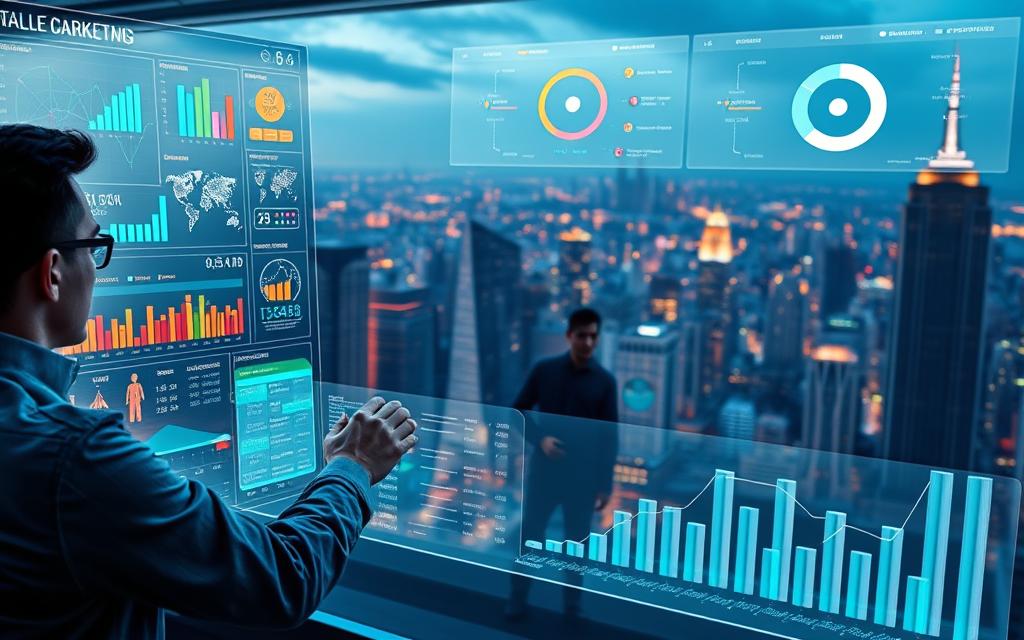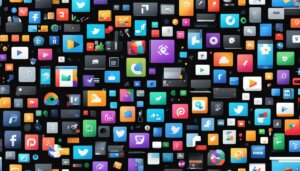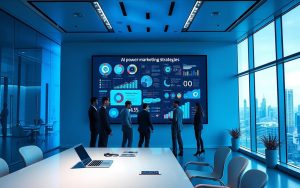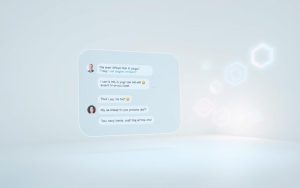Table of Contents
Modern marketing thrives on innovation, and artificial intelligence is leading the charge. According to The Conference Board, 87% of marketers now leverage AI-driven tools to enhance their campaigns. This shift isn’t surprising—automation and personalization deliver measurable results.
From predictive analytics to chatbots, AI transforms how brands engage audiences. HubSpot’s suite of strategies exemplifies this evolution, offering smarter content creation and customer insights. Businesses of all sizes benefit, gaining efficiency and higher ROI.
Ready to explore practical applications? This guide breaks down actionable steps for seamless integration. Stay ahead by harnessing cutting-edge tools that redefine success.
Introduction to AI in Business Marketing
The digital landscape evolves rapidly, and artificial intelligence sits at its core. A HubSpot survey reveals 64% of marketers now rely on AI-powered solutions. These tools streamline workflows, analyze vast datasets, and sharpen customer engagement.
Data drives decisions. About 40% of professionals leverage AI for sentiment analysis and predictive modeling. Small businesses gain an edge too—voice search optimization helps local restaurants attract nearby diners effortlessly.
Platforms like frase.io enhance content strategies with SEO precision. “AI isn’t just for giants,” notes a tech analyst. “Even boutique brands see 68% daily efficiency boosts.”
Yet ethical questions linger. Transparency in data usage remains critical as technology reshapes consumer interactions. The balance between automation and human touch defines modern success.
Why AI is a Game-Changer for Marketing
Artificial intelligence reshapes marketing by turning manual processes into seamless workflows. HubSpot reports marketers save 2 hours and 24 minutes daily through automation. This shift lets teams prioritize strategy over mundane tasks.
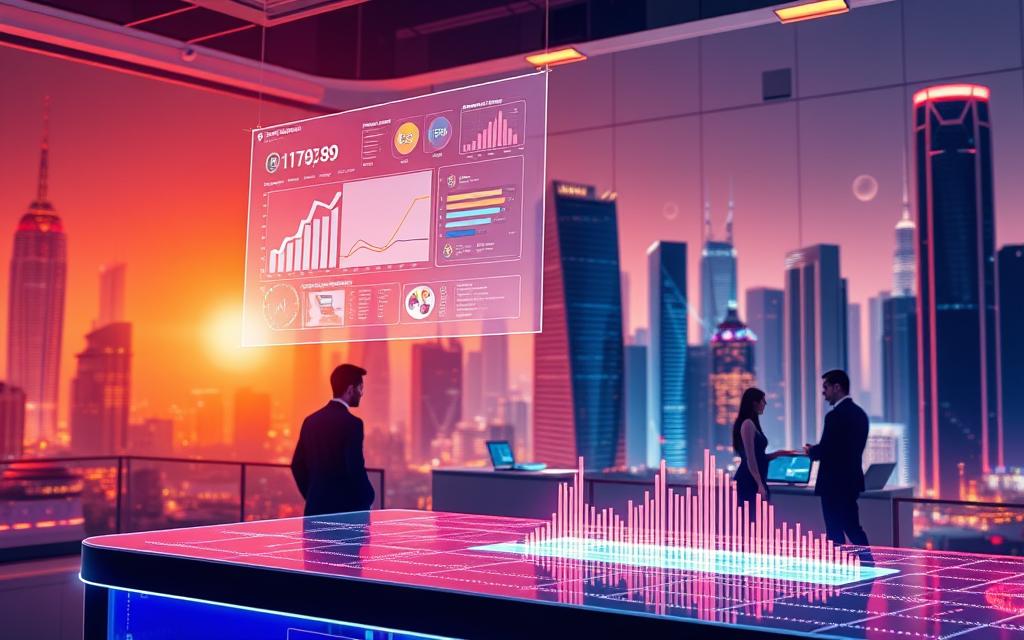
Automation of Repetitive Tasks
Email campaigns no longer demand hours of manual effort. Tools like Superhuman leverage AI to draft, sort, and schedule messages—saving 5+ hours weekly. Efficiency soars when routine tasks vanish.
Netflix’s artwork personalization demonstrates AI’s power. Algorithms test thumbnails for each viewer, boosting engagement by 35%. Similarly, interactive emails see 3X higher conversions through dynamic content.
Data-Driven Decision Making
Amazon’s recommendation engine drives 35% of sales by analyzing user behavior. Data-powered insights predict preferences, ensuring relevancy. AI-driven analytics platforms automate market research, uncovering audience trends instantly.
Drift’s conversational AI engages visitors 24/7, capturing leads even after hours. Real-time adjustments in ad bids maximize ROI by targeting high-intent users. The result? Smarter spending and higher conversions.
How to Use AI for Business Marketing: Key Strategies
Brands leveraging AI see 41% higher revenue from personalized emails, reports Businessdit. The right strategies turn data into engagement, blending automation with creativity. Focus on two pillars: tailored experiences and ad precision.
Personalizing Customer Experiences
Spotify’s playlist personalization boosts retention by 30%. AI analyzes listening habits, suggesting songs that feel handpicked. Tools like 6Sense refine this further, predicting audience intent before searches occur.
Dynamic content adapts in real time. A travel site might show beach deals to users researching vacations. DreamHost’s AI name generator even crafts brand identities aligned with target demographics.
Optimizing Ad Campaigns
Adcreative.ai slashes ad design time while lifting click-through rates. A/B testing AI-generated variations identifies top performers instantly. Pattern89’s programmatic tools adjust bids based on real-time campaigns data.
HubSpot’s Campaign Assistant drafts ad copy that resonates. Combined with cost-per-click optimization, brands see sales climb without budget spikes. The result? Smarter spending and higher conversions.
Top AI Tools for Marketing Success
Efficiency meets creativity with AI-powered marketing tools. These platforms streamline workflows, from drafting blogs to qualifying leads. Brands leveraging them report 50% faster campaign execution and higher engagement.

Content Creation Tools
Jasper.ai and Copy.ai lead in content creation. Jasper excels in long-form blogs, while Copy.ai offers 90+ templates for ads and social posts. Key differences:
- Jasper.ai: Ideal for SEO-optimized articles with a brand voice.
- Copy.ai: Faster for short-form copy like email subject lines.
HubSpot’s Content Assistant refines drafts with real-time SEO suggestions. Meanwhile, Phrasee boosts open rates by 30% with AI-generated subject lines.
Chatbots and Customer Support
Drift’s chatbots use NLP to qualify leads in seconds. Its conversational AI captures emails even at midnight. Verloop.io handles 24/7 support, resolving 70% of queries without human intervention.
For e-commerce, these tools reduce cart abandonment by 20%. They analyze intent, offering discounts or FAQs dynamically.
From logos (Designs.ai) to video scripts (Pictory.ai), AI reshapes digital marketing. The right platform aligns with your goals—speed, scalability, or hyper-personalization.
Enhancing Content Creation with AI
Nearly 40% of marketers now integrate AI into their creative workflows. These tools accelerate ideation, drafting, and publishing—transforming how brands connect with audiences. Whether crafting blogs or editing videos, automation ensures consistency and scale.
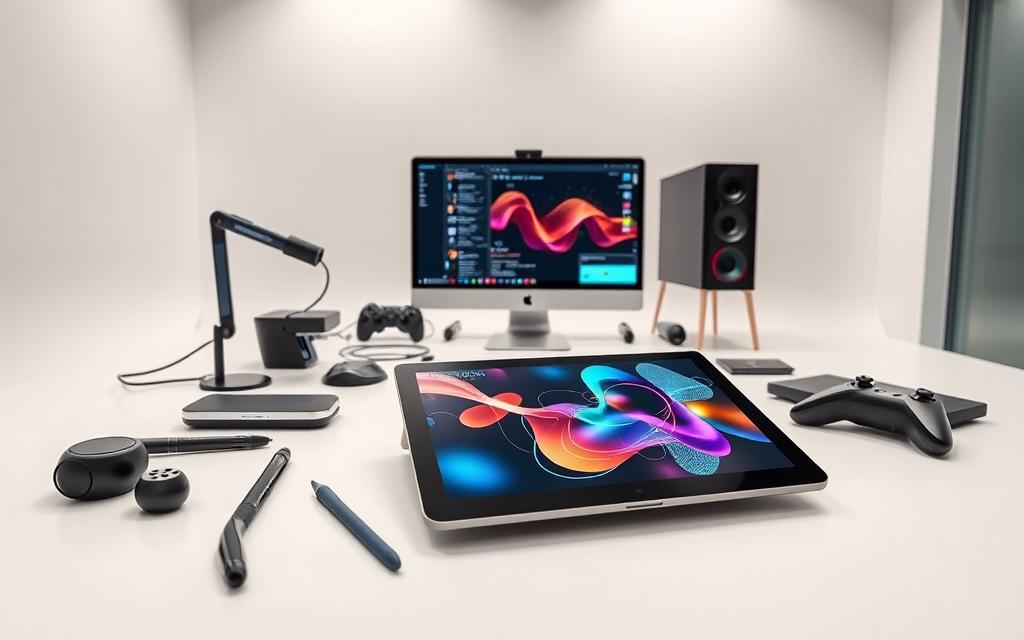
Streamlining Blogs and Social Media
ChatGPT turns recipes into Instagram Reels scripts in seconds. Avimee’s case study shows a 50% reduction in time spent drafting social media captions. Key advantages of AI-assisted posts:
- Speed: Canva’s Magic Write generates visuals and captions simultaneously.
- Precision: SEMrush’s templates optimize content creation for SEO.
- Adaptability: GrammarlyGO adjusts tone to match brand voice.
AI-Powered Video Marketing
Pictory.ai converts blog scripts into engaging video summaries. Lumen5’s text-to-video feature slashes production time by 70%. Brands like HubSpot use these tools to repurpose blogs into TikTok clips—tripling engagement.
Human oversight remains critical. AI drafts save hours, but final edits ensure authenticity. The blend of automation and creativity drives results.
Automating Customer Interactions
Customer engagement now operates around the clock, thanks to AI-driven automation. HubSpot reveals 63% of businesses use these tools for meetings and inquiries. This shift ensures no query goes unanswered, day or night.
Always-On Chatbot Solutions
Platforms like Intercom and Drift handle 70% of customer questions instantly. Their chatbots use natural language processing to:
- Qualify leads in under 30 seconds
- Route complex issues to human agents
- Schedule meetings without calendar conflicts
Gorgias shows impressive results—resolving 82% of e-commerce tickets automatically. Zendesk’s Answer Bot reduces response times by 4 hours on average.
Smart Email Systems
Phrasee boosts email open rates by 13.44% with AI-generated subject lines. These responses adapt based on:
- Recipient engagement history
- Time zone optimization
- Behavioral triggers
Verloop.io integrates with CRMs to send personalized follow-ups. Its workflow automation cuts email handling time by 55%.
| Platform | Strength | Impact |
|---|---|---|
| Drift | Conversational AI | 28% more qualified leads |
| HubSpot | Meeting automation | 63% note-taking accuracy |
| Intercom | Custom bot builders | 40% faster resolution |
These automation tools create seamless experiences. Customer satisfaction scores rise when responses feel instant and relevant.
Leveraging Predictive Analytics
Predictive analytics transforms marketing by turning raw data into actionable strategies. Companies like Amazon use it to drive 35% of sales through personalized recommendations. Behavioral insights from tools like 6Sense forecast customer intent before searches even occur.
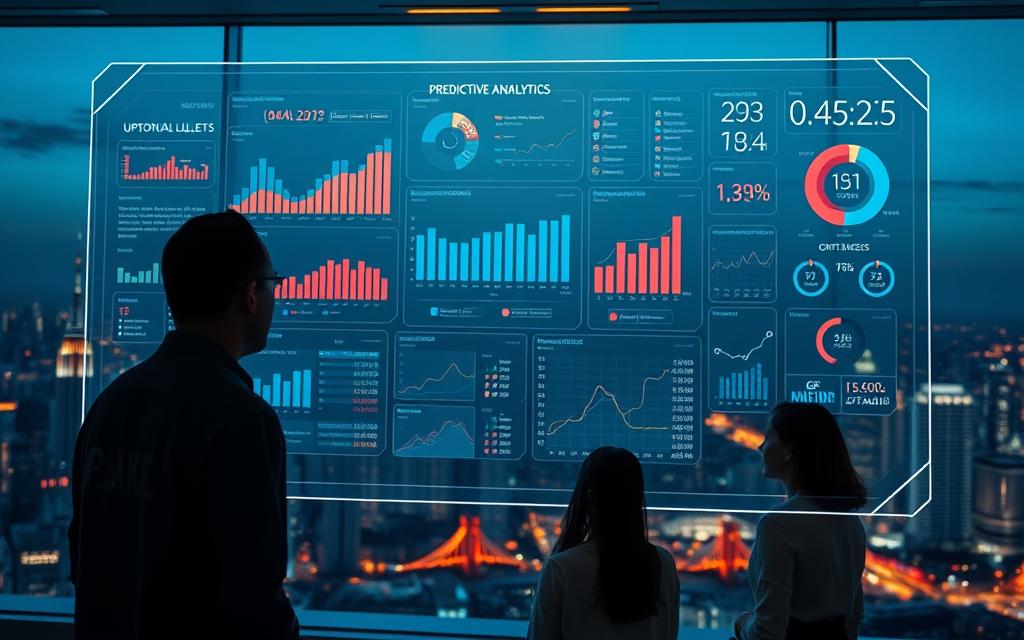
Forecasting Customer Behavior
Netflix analyzes viewing patterns to suggest thumbnails, boosting engagement by 35%. Key tactics include:
- Churn prediction models: Salesforce Einstein accurately flags at-risk customers.
- Intent tracking: Google Analytics predicts metrics like purchase likelihood.
Improving Campaign ROI
Dynamic budget allocation adjusts ad spend based on real-time campaign performance. For example:
- Programmatic tools reallocate funds to high-converting audiences.
- A/B testing identifies top-performing creatives instantly.
These methods deliver measurable results, ensuring every dollar maximizes impact.
AI in Social Media Management
Social media platforms now rely heavily on AI to streamline engagement and boost performance. A CMO Study reveals 30% of brands automate posts, saving hours while increasing consistency. Tools like Hootsuite Amplify schedule content across networks, ensuring optimal posting times.
Scheduling and Post Optimization
Later’s visual calendar simplifies planning by auto-pinning posts to peak engagement slots. Avimee’s Instagram automation tests captions and hashtags, lifting reach by 22%.
HubSpot tracks ROI with AI-driven analytics, linking social media efforts to conversions. Key features include:
- Real-time adjustments: Sprout Social benchmarks competitors’ top-performing content.
- Sentiment analysis: Emplifi detects brand mentions, flagging negative feedback instantly.
Audience Insights and Trends
TikTok’s Creative Center identifies viral trends, guiding content strategies. Brandwatch predicts emerging topics, helping brands stay ahead.
AI deciphers audience behavior, like:
- Demographic shifts (e.g., Gen Z’s preference for video)
- Engagement patterns (best days/times for replies)
These management tools transform raw data into actionable strategies, ensuring every post resonates.
Programmatic Advertising with AI
Programmatic advertising revolutionizes digital marketing with precision targeting. Platforms like Google Ads use AI auction systems to place ads in milliseconds, analyzing user intent and bid prices. This automation ensures brands connect with their target audience at optimal moments.
Real-Time Ad Placement
The Trade Desk’s bid strategies adjust dynamically based on:
- Audience engagement: Criteo’s dynamic product ads refresh based on browsing history
- Contextual relevance: MediaMath segments users by purchase likelihood
- Location signals: Simpli.fi’s geotargeting serves local promotions
Adobe Advertising Cloud predicts campaigns performance, shifting budgets to high-converting channels. YouTube’s smart bidding prioritizes viewers most likely to watch full videos.
Targeting the Right Audience
Adcreative.ai boosts conversions by testing thousands of ad variations automatically. Key tactics include:
- Native platform integration (Taboola, Outbrain)
- Behavioral triggers (abandoned cart reminders)
- Demographic filters (age, income tiers)
These digital marketing tools ensure messages resonate. A retail brand using these methods saw 47% higher click-through rates in Q3 2024.
Overcoming Challenges in AI Adoption
While AI offers immense potential, implementation isn’t without obstacles. HubSpot reports 47% of users encounter inaccuracies, while 40% fear job impacts (Conference Board). Balancing innovation with ethical and operational challenges ensures sustainable success.
Data Privacy Concerns
Data privacy remains a top risk. GDPR compliance requires transparent data usage and storage protocols. Key steps to mitigate issues:
- Bias mitigation: IBM’s ethics framework audits algorithms for fairness.
- Transparency documentation: Disclose AI-generated content per FTC guidelines.
- Legal precedents: California’s AB-331 sets standards for automated decision-making.
Balancing AI and Human Creativity
AI excels at scale, but human oversight preserves brand authenticity. Upwork’s hybrid teams blend AI drafts with editor reviews. Best practices:
- Editing workflows: GrammarlyGO suggests edits while retaining voice.
- Creative collaboration: Canva’s Magic Design generates layouts designers refine.
As technology evolves, the synergy between creativity and automation defines competitive advantage.
Future Trends in AI-Driven Marketing
The next wave of marketing innovation is already here, powered by intelligent systems. Insider Intelligence notes a 10X increase in public AI adoption since 2023. This surge reflects growing demand for seamless, predictive customer experiences.
Voice interfaces and microscopic personalization redefine engagement. Technology now adapts to individual behaviors in real time. Brands mastering these trends gain measurable competitive edges.
Voice Search Optimization
Over 50% of U.S. households use voice assistants monthly. Optimizing for voice search requires:
- Alexa skill development for hands-free brand interactions
- Alignment with Google’s BERT updates for natural language learning
- Local SEO refinements for “near me” queries
Starbucks’ voice ordering system processes 20% of mobile orders. Such implementations demand real-time data parsing and conversational UI design. The payoff? Deeper customer connections.
Hyper-Personalization
Dynamic pricing algorithms now adjust offers based on browsing history. Sephora’s AR try-on tool boosts conversions by 11%. Key developments include:
- Neuromarketing AI analyzing emotional responses to ads
- ChatGPT-4 generating multimodal content (text-to-3D)
- Virtual influencers like Lil Miquela securing brand deals
These hyper-personalization tactics rely on deep learning models. They transform generic campaigns into one-to-one conversations. The future belongs to brands embracing this granular approach.
Conclusion
The marketing landscape shifts fast, and AI-driven tools lead the charge. Companies adopting these solutions report 82% higher productivity, according to The Conference Board. Start with content creation platforms—they offer quick wins while teams adapt.
Success hinges on blending strategy with automation. Focus on personalization and data-driven adjustments. These steps refine the process, boosting engagement and sales.
Skill development remains critical. HubSpot Academy’s courses help teams master AI integration. Early adopters gain competitive edges as technology evolves.
By 2025, hyper-personalization will dominate. Brands leveraging AI now will stay ahead. The results speak for themselves—smarter workflows, higher ROI, and lasting customer connections.
FAQ
What are the best AI tools for content creation in marketing?
Leading tools like Jasper.ai and Copy.ai help generate high-quality blog posts, ads, and social media content quickly. These platforms use machine learning to refine messaging for better engagement.
How does AI improve customer interactions in marketing?
AI-powered chatbots such as Drift provide 24/7 support, while automated email systems personalize responses based on user behavior. This boosts satisfaction and reduces response times.
Can AI optimize social media marketing campaigns?
Yes. AI analyzes audience trends, schedules posts at peak times, and suggests content adjustments. Tools like Hootsuite Insights leverage predictive analytics for higher engagement.
What role does predictive analytics play in marketing?
It forecasts customer actions, like purchase likelihood, by analyzing past behavior. This helps refine ad spend and tailor campaigns for maximum ROI.
How does AI handle programmatic advertising?
AI automates real-time ad bidding, ensures precise audience targeting, and adjusts placements dynamically. Platforms like Google Ads use this to enhance performance.
Are there privacy concerns with AI in marketing?
Absolutely. Businesses must comply with regulations like GDPR and ensure transparent data usage. Balancing personalization with privacy is critical.
What are emerging AI trends in marketing?
Voice search optimization and hyper-personalization are rising. Brands using Amazon Alexa or Google Assistant integrations gain an edge in customer experience.


